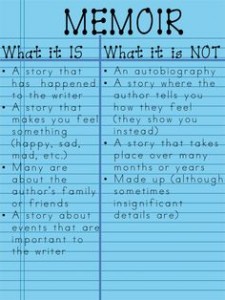Who knew that Graham Greene, a writer I admired when I was younter, wrote a Christmas short story set in Calgary? It sounds creepy, too. Makes me think I should revisit Greene. 
All posts by admin
NaMeWriMo
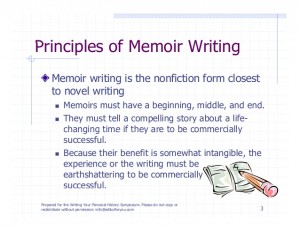
My National Novel Writing Month project this fall wasn’t a novel — it was a memoir. I decided this was allowed, since memoir is, in many ways, closer to novels and than it is to other non-fiction. On the whole, while writing the book last month, I found memoir closer to fiction than I expected.
Writing a memoir this fall surprised me more than anyone. I first thought of this book idea about a week before NaNoWriMo was due to start. It came out of my musings on how to promote my newly completed novel. Publication could be far down the road, but I had the time now to consider issues from the novel that I might write or speak about to attract an audience to the fiction story. Being me with my novel brain, the ideas morphed into a larger concept. NaNo was coming up and I figured, why not give it a try? If nothing else, exploring memoir, a new genre (for me), would be a good writing exercise and, possibly, help me work up some short articles and talks from the material.
And so, my NaMeWriMo project was born. Check out my blog posts today and next week for more reflections as I progressed through the writing process.
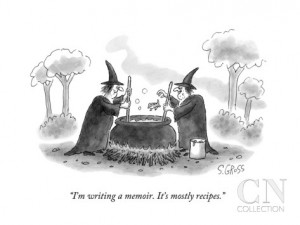
Memoir vs. Autobiography
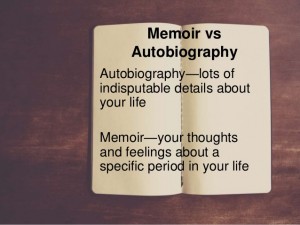 Before starting my memoir, I was pretty clear on the difference between memoir and autobiography, mainly thanks to information I’ve absorbed from writer friends working in the genre. But these reminder images don’t hurt, especially since I found that, while writing my memoir, I had a tendency to ‘tell’ (vs. show) more than I do in fiction. In places, I felt like a post-modern narrator commenting from outside the story. I’m not sure this is always wrong for this particular book, but ‘showing’ is usually more powerful.
Before starting my memoir, I was pretty clear on the difference between memoir and autobiography, mainly thanks to information I’ve absorbed from writer friends working in the genre. But these reminder images don’t hurt, especially since I found that, while writing my memoir, I had a tendency to ‘tell’ (vs. show) more than I do in fiction. In places, I felt like a post-modern narrator commenting from outside the story. I’m not sure this is always wrong for this particular book, but ‘showing’ is usually more powerful.
- I’m less rigid now about the need for memorists to stick to the literal truth. It’s so hard to remember the details when you weren’t taking notes.
That I can learn from these image bytes makes me realize I have a lot to learn about writing memoir.
Next week’s post: Memoir vs. Fiction
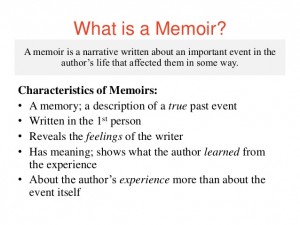
Vienna on the Bow
Here’s a writer’s view of boomtown in the early 20th century, with a photo of a never realized plan of Calgary as ‘Vienna on the Bow.’ Anyone up for the Blue Bow Polka? 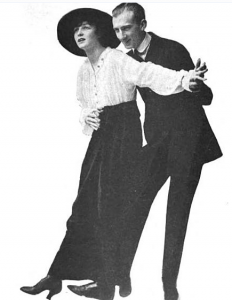
NaNoWriMo is over
 National Novel Writing Month is over. I both lost and won.
National Novel Writing Month is over. I both lost and won.
Win: I accomplished my primary goal of completing a first draft of my book idea.
Win/lose: It’s a short book – 31,327 words. I don’t know if it’s expandable enough to publish traditionally, if it’s publishable at all.
Win: Regardless, it was a worthwhile writing experience.
Lose: I didn’t reach the NaNo goal of writing 50,000 words during the month of November.
I finished the book draft on Nov 19th and had planned to continue piling up words with other writing projects. This would have been fun, since I loved adding my word count to the NaNo stats at the end of each writing day. But I decided, in the end, I’d benefit more by devoting the last weeks of the month to other matters, including reading the massive short story collection Family Furnishings by Alice Munro for my book club. For me, NaNo didn’t allow much time to do anything else, and I mean anything.
Congratulations to all those who won/won NaNoWriMo and completed both their drafts and 50,000 words. I know now that is a massive task. 
Searching the past
Author Dale Lee Kwong’s Calgary story is a heart-wrenching search for her past.
Giller Bash photos
Check out these photos from Calgary’s Giller Bash last week. A well-attended fun event, as seen in the smiling faces.
Devonian Sea
Author Bruce Hunter wrote about Calgary metaphorically in his story set in the early 1960s, when the neighbourhood of Ogden was at the southeast edge of the city. I live south of Ogden and Calgary stretches way to the south and east of my home.
How to Write a Novel in Your Spare Time
Fall 2003 to Spring 2014 was my mystery writing decade. Naturally, there were breaks for holidays and personal matters, but most of my writing hours were spent on Deadly Fall and its sequels. 
In 2009, a longer break provided the time to start the new To Catch a Fox. I wrote my protagonist Julie and her stepsister onto the plane to California. They found their way to the Italian-styled retreat.
At this point in the writing, I attended the 10 day summer Sage Hill Writing Experience Fiction Colloquium facilitated by author Catherine Bush. The colloquium gave me writing time to finish the draft and Catherine’s feedback assured me my new concept wasn’t totally off-base. Her comments launched me into the second draft, which I completed that fall.
The next spring Deadly Fall‘s acceptance by TouchWood Editions shifted me back to mystery. I spent the summer working on the manuscript with my editor. In the fall, I polished the mystery sequel, sent it to my publisher and started a third book in the series. Almost three years passed before I returned to the fox. 
From winter to spring 2013, I finished the third draft and applied once again to the Sage Hill Fiction Colloquium, this time with facilitator Lawrence Hill. This would be my third visit to Sage Hill and I find its isolated and enclosed environment condusive to writing and learning. Hill’s critique helped me improve the book and my writing skills. His advice at the end of the program was, after my next draft, to get a manuscript evaluation from the Writers Union.
It took me a year and a half to finish the fourth draft, largely due to pulls to the mystery side. My publisher was leaving to join a new company. She had problems with both of my sequels and didn’t feel she could recommend it to her successor. I talked this over with my friend and mystery author Eileen Coughlan, who gave me a clue for a fresh start. I wrote a new first chapter, moved the former opening to chapter three and quickly edited the rest of the novel to make sure the whole worked. 
With draft # 4 complete, I looked into the Writers Union Manuscript Critique service, which functions anonymously. The writer doesn’t put her name on the manuscript and doesn’t know who the evaluator is. I’m sure there are advantages to this approach, but I decided that for the same cost I’d rather go with a writer/editor I knew. Among other things, there might be some back and forth comments and clarifications after the evaulation was done.
I stumbled upon author-editor Pearl Luke, whose novel I had enjoyed in the past. Pearl’s comments on my manuscript were both encouraging and a challenge. I also gave the novel to my two critique group writer-friends. I revised the book based on Pearl’s remarks and asked two relatives who are avid readers to review the manuscript. The husband of one of them got a hold of it and provided feedback too. Then, a friend from an email writing group suggested we exchange our work and I gave her the first 200 pages to critique.
It wasn’t easy to assemble this multitude of varied remarks and decide which to accept, which to reject (at least for now) and which to use in a modified way. Editing isn’t my favourite summer project, but I didn’t want to delay this to fall or later. Somehow, I managed to get the job done while enjoying a summer of outdoor activities and visits from family and friends. Getting up two hours earlier than ususal a few mornings helped. Who needs sleep? 
At the summer’s end, I had a manuscript that I believed was as good as I could get it for now and ready to send to the world.
In a way, it feels like I’ve been working on To Catch a Fox forever. The novel has been there in some form since almost the beginning of my writing career, even when I put it in the drawer. 
On the other hand, the current story feels like it was written in my spare time, during the breaks from my main job of writing murder mystery.
Sometimes the real stuff happens when you aren’t looking.
Day 13
Day 13 of National Novel Writing Month. It sure is grueling to try to write 50,000 words in one month, but NaNo has pushed me forward. My word count slipped today, but I’m still a little ahead of the target and on track to reach the goal on Nov 28th. NaNo provides stats and a graph showing your progress and updates them every time you add words to your count. It’s fun and could turn anyone into a numbers geek. 
